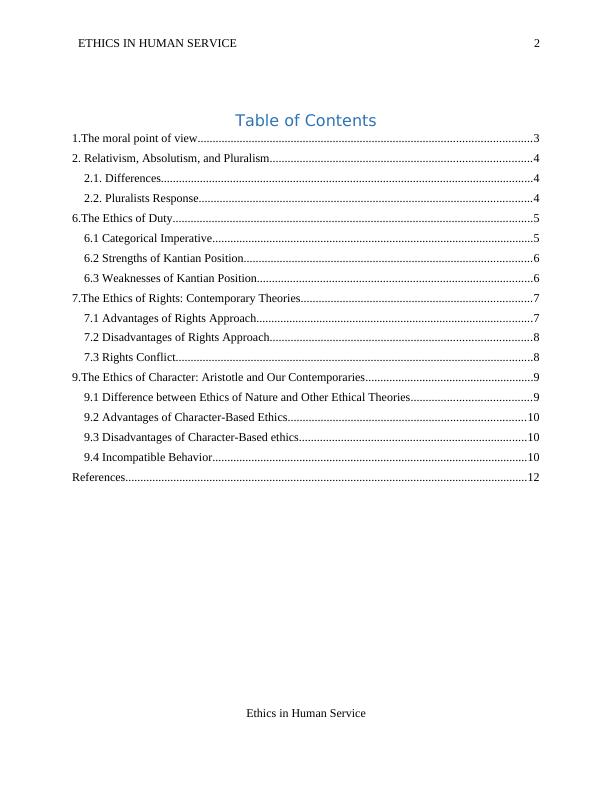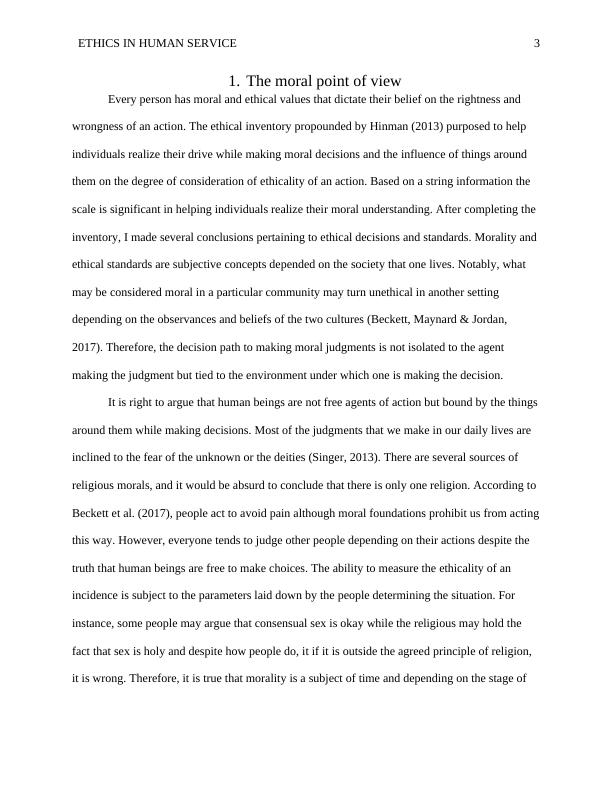Ethics in Human Service
Added on 2023-06-08
13 Pages3914 Words500 Views
Running head: ETHICS IN HUMAN SERVICE 1
Ethics in Human Service
Student Name
Institutional Affiliation
Ethics in Human Service
Student Name
Institutional Affiliation

ETHICS IN HUMAN SERVICE 2
Table of Contents
1.The moral point of view...............................................................................................................3
2. Relativism, Absolutism, and Pluralism.......................................................................................4
2.1. Differences............................................................................................................................4
2.2. Pluralists Response...............................................................................................................4
6.The Ethics of Duty........................................................................................................................5
6.1 Categorical Imperative...........................................................................................................5
6.2 Strengths of Kantian Position................................................................................................6
6.3 Weaknesses of Kantian Position............................................................................................6
7.The Ethics of Rights: Contemporary Theories.............................................................................7
7.1 Advantages of Rights Approach............................................................................................7
7.2 Disadvantages of Rights Approach.......................................................................................8
7.3 Rights Conflict.......................................................................................................................8
9.The Ethics of Character: Aristotle and Our Contemporaries........................................................9
9.1 Difference between Ethics of Nature and Other Ethical Theories........................................9
9.2 Advantages of Character-Based Ethics...............................................................................10
9.3 Disadvantages of Character-Based ethics............................................................................10
9.4 Incompatible Behavior.........................................................................................................10
References......................................................................................................................................12
Ethics in Human Service
Table of Contents
1.The moral point of view...............................................................................................................3
2. Relativism, Absolutism, and Pluralism.......................................................................................4
2.1. Differences............................................................................................................................4
2.2. Pluralists Response...............................................................................................................4
6.The Ethics of Duty........................................................................................................................5
6.1 Categorical Imperative...........................................................................................................5
6.2 Strengths of Kantian Position................................................................................................6
6.3 Weaknesses of Kantian Position............................................................................................6
7.The Ethics of Rights: Contemporary Theories.............................................................................7
7.1 Advantages of Rights Approach............................................................................................7
7.2 Disadvantages of Rights Approach.......................................................................................8
7.3 Rights Conflict.......................................................................................................................8
9.The Ethics of Character: Aristotle and Our Contemporaries........................................................9
9.1 Difference between Ethics of Nature and Other Ethical Theories........................................9
9.2 Advantages of Character-Based Ethics...............................................................................10
9.3 Disadvantages of Character-Based ethics............................................................................10
9.4 Incompatible Behavior.........................................................................................................10
References......................................................................................................................................12
Ethics in Human Service

ETHICS IN HUMAN SERVICE 3
1. The moral point of view
Every person has moral and ethical values that dictate their belief on the rightness and
wrongness of an action. The ethical inventory propounded by Hinman (2013) purposed to help
individuals realize their drive while making moral decisions and the influence of things around
them on the degree of consideration of ethicality of an action. Based on a string information the
scale is significant in helping individuals realize their moral understanding. After completing the
inventory, I made several conclusions pertaining to ethical decisions and standards. Morality and
ethical standards are subjective concepts depended on the society that one lives. Notably, what
may be considered moral in a particular community may turn unethical in another setting
depending on the observances and beliefs of the two cultures (Beckett, Maynard & Jordan,
2017). Therefore, the decision path to making moral judgments is not isolated to the agent
making the judgment but tied to the environment under which one is making the decision.
It is right to argue that human beings are not free agents of action but bound by the things
around them while making decisions. Most of the judgments that we make in our daily lives are
inclined to the fear of the unknown or the deities (Singer, 2013). There are several sources of
religious morals, and it would be absurd to conclude that there is only one religion. According to
Beckett et al. (2017), people act to avoid pain although moral foundations prohibit us from acting
this way. However, everyone tends to judge other people depending on their actions despite the
truth that human beings are free to make choices. The ability to measure the ethicality of an
incidence is subject to the parameters laid down by the people determining the situation. For
instance, some people may argue that consensual sex is okay while the religious may hold the
fact that sex is holy and despite how people do, it if it is outside the agreed principle of religion,
it is wrong. Therefore, it is true that morality is a subject of time and depending on the stage of
1. The moral point of view
Every person has moral and ethical values that dictate their belief on the rightness and
wrongness of an action. The ethical inventory propounded by Hinman (2013) purposed to help
individuals realize their drive while making moral decisions and the influence of things around
them on the degree of consideration of ethicality of an action. Based on a string information the
scale is significant in helping individuals realize their moral understanding. After completing the
inventory, I made several conclusions pertaining to ethical decisions and standards. Morality and
ethical standards are subjective concepts depended on the society that one lives. Notably, what
may be considered moral in a particular community may turn unethical in another setting
depending on the observances and beliefs of the two cultures (Beckett, Maynard & Jordan,
2017). Therefore, the decision path to making moral judgments is not isolated to the agent
making the judgment but tied to the environment under which one is making the decision.
It is right to argue that human beings are not free agents of action but bound by the things
around them while making decisions. Most of the judgments that we make in our daily lives are
inclined to the fear of the unknown or the deities (Singer, 2013). There are several sources of
religious morals, and it would be absurd to conclude that there is only one religion. According to
Beckett et al. (2017), people act to avoid pain although moral foundations prohibit us from acting
this way. However, everyone tends to judge other people depending on their actions despite the
truth that human beings are free to make choices. The ability to measure the ethicality of an
incidence is subject to the parameters laid down by the people determining the situation. For
instance, some people may argue that consensual sex is okay while the religious may hold the
fact that sex is holy and despite how people do, it if it is outside the agreed principle of religion,
it is wrong. Therefore, it is true that morality is a subject of time and depending on the stage of

ETHICS IN HUMAN SERVICE 4
development, the ethicality of an incidence can be determined (Hinman, 2012). Consequently,
we are all bound to act in a specific manner delineated by the society as the moral path.
2. Relativism, Absolutism, and Pluralism
2.1. Differences
A moral consideration, when reflected under relativism, absolutism, and pluralism,
implies different thing under the different isms. From a relativist point of view, there is no point
of agreement on what is right or wrong because every society has its description of moral actions
(Kusch, 2017). For instance, polygamy is allowed among Islamic while it is condemned in
Christianity. For pluralist, every observance is important, and cultures must enable views from
others and maintain their beliefs too (Hinman, 2012). Pluralist demand that people should
consider others decisions before condemning them. On the other, absolutism emphasizes a
particular culture is the best, and no one can challenge it (Siegel, 2017). Therefore, no right thing
exists outside that culture and if it does, it is morally unacceptable. Consequently, moral
decisions made by individuals are subject to the three perceptions of the actions.
2.2. Pluralists Response
Pluralists are accommodative to the beliefs inside and outside a particular system of
beliefs. Therefore, they try to understand why people behave in a specific way and observe
certain things. Female Genital Mutilation (FGM) is a contentious topic in the world today. Both
sides of the divide hold certain perception leading them to condemn or support the practice.
However, a moral pluralist will be lenient while responding to forced female circumcision
(Kusch, 2017). For this ethical point of view, it is important to dig deep into the motivation
behind carrying out FGM before condemning those who do it. Indeed, pro-FGM societies have
genuine intentions for passing the culture activity to their generations. However, the anti-FGM
movements and individuals fail to get the gist behind the action denying a point of understanding
development, the ethicality of an incidence can be determined (Hinman, 2012). Consequently,
we are all bound to act in a specific manner delineated by the society as the moral path.
2. Relativism, Absolutism, and Pluralism
2.1. Differences
A moral consideration, when reflected under relativism, absolutism, and pluralism,
implies different thing under the different isms. From a relativist point of view, there is no point
of agreement on what is right or wrong because every society has its description of moral actions
(Kusch, 2017). For instance, polygamy is allowed among Islamic while it is condemned in
Christianity. For pluralist, every observance is important, and cultures must enable views from
others and maintain their beliefs too (Hinman, 2012). Pluralist demand that people should
consider others decisions before condemning them. On the other, absolutism emphasizes a
particular culture is the best, and no one can challenge it (Siegel, 2017). Therefore, no right thing
exists outside that culture and if it does, it is morally unacceptable. Consequently, moral
decisions made by individuals are subject to the three perceptions of the actions.
2.2. Pluralists Response
Pluralists are accommodative to the beliefs inside and outside a particular system of
beliefs. Therefore, they try to understand why people behave in a specific way and observe
certain things. Female Genital Mutilation (FGM) is a contentious topic in the world today. Both
sides of the divide hold certain perception leading them to condemn or support the practice.
However, a moral pluralist will be lenient while responding to forced female circumcision
(Kusch, 2017). For this ethical point of view, it is important to dig deep into the motivation
behind carrying out FGM before condemning those who do it. Indeed, pro-FGM societies have
genuine intentions for passing the culture activity to their generations. However, the anti-FGM
movements and individuals fail to get the gist behind the action denying a point of understanding

End of preview
Want to access all the pages? Upload your documents or become a member.
Related Documents
Workplace Sexual Harassmentlg...
|6
|913
|169
Individual Report On Ethical Issueslg...
|5
|954
|73
Ethics in Medical Research: Utilitarian and Kantian Ethicslg...
|5
|1055
|133
Business Ethicslg...
|5
|757
|77
Analysis of Kantian’s Good Willlg...
|5
|1052
|446
Criticism of the Utilitarian Theorylg...
|10
|2467
|328
